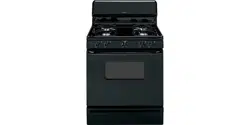Documents: Go to download!
- Owner's manual - (English)
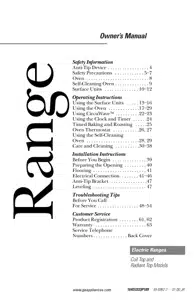
- Operating Instructions
- Installation Instructions
- Troubleshooting Tips
- Consumer Product Ownership Registration
- Electric Range Warranty
Table of contents
Owner’s Manual Ranges
Operating Instructions
Using the surface units.
How to Set

Push the knob in and turn in either direction to the setting you want.
At both OFF and HI the control clicks into position. You may hear slight clicking sounds during cooking, indicating the control is keeping the power level you set
Indicator Lights (on radiant glass models only)
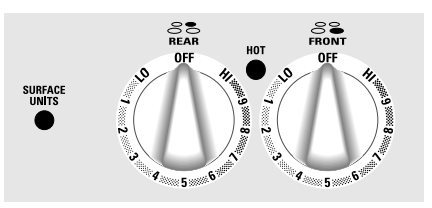
A HOT indicator light will glow when any radiant element is turned on, and will remain on until the surface is cool enough to touch.
A SURFACE UNITS on indicator light will glow when any surface unit is on.
NOTE: The SURFACE UNITS on indicator light may glow between the surface control settings of LO and OFF, but there is no power to the surface units.
Using the radiant surface units (on some models)
About the radiant surface units…

The radiant cooktop features heating units beneath a smooth glass surface.
NOTE: A slight odor is normal when a new cooktop is used for the first time. It is caused by the heating of new parts and insulating materials and will disappear in a short time. The surface unit will cycle on and off to maintain your selected control setting.
It is safe to place hot cookware from the oven or surface on the glass surface when the surface is cool.
Even after the surface units are turned off, the glass cooktop retains enough heat to continue cooking. To
avoid over-cooking, remove pans from the surface units when the food is cooked. Avoid placing anything on the surface unit until it has cooled completely.
- Water stains (mineral deposits) are removable using the cleaning cream or full strength white vinegar.
- Use of window cleaner may leave an iridescent film on the cooktop. The cleaning cream will remove this discoloration.
- Don’t store heavy items above the cooktop. If they drop onto the cooktop, they can cause damage.
- Do not use the surface as a cutting board.
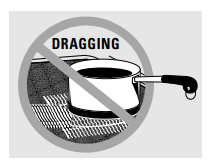
Selecting types of cookware for radiant glass cooktop models
The following information will help you choose cookware which will give good performance on glass cooktops.

Stainless Steel: recommended
Aluminum: heavy weight recommended
- Good conductivity. Aluminum residues sometimes appear as scratches on the cooktop, but can be removed if cleaned immediately. Because of its low melting point, thin weight aluminum should not be used.
Copper Bottom: recommended
- Copper may leave residues which can appear as scratches. The residues can be removed, as long as the cooktop is cleaned immediately. However, do not let these pots boil dry. Overheated metal can bond to glass cooktops. An overheated copper bottom pot will leave a residue that will permanently stain the cooktop if not removed immediately
Porcelain Enamel Covered Cast Iron: recommended
- As long as the cookware is covered completely with porcelain enamel, this cookware is recommended. Caution is recommended for cast iron cookware that is not completely covered with smooth porcelain enamel, as it may scratch the glass ceramic cooktop.
Glass-ceramic: usable, but not recommended
- Poor performance. May scratch the surface.
Stoneware: usable, but not recommended
- Poor performance. May scratch the surface.
Selecting types of cookware for coil cooktop models
The following information will help you choose cookware which will give good performance on coil cooktops.
Surface Cookware Tips

Use medium- or heavy-weight cookware. Aluminum cookware conducts heat faster than other metals. Cast-iron and coated cast-iron cookware are slow to absorb heat, but generally cook evenly at low to medium heat settings. Steel pans may cook unevenly if not combined with other metals.
For best cooking results, pans should be flat on the bottom. Match the size of the saucepan to the size of the surface unit. The pan should not extend over the edge of the surface unit more than 1 inch.
Wok Cooking

We recommend that you use only a flat-bottomed wok. They are available at your local retail store.
Do not use woks that have support rings. Use of these types of woks, with or without the ring in place, can be dangerous. Placing the ring over the surface unit will cause a build-up of heat that will damage the porcelain cooktop. Do not try to use such woks without the ring. You could be seriously burned if the wok tipped over.
Using the oven controls.
Throughout this manual, features and appearance may vary from your model.

Clock and Timer Features
- COOK TIME ON/OFF Pad - Press this pad and then press the HOUR and MIN. pads to set the amount of time you want your food to cook. Turn the Oven Temperature knob to the desired temperature. The oven will shut off when the Cook Time has run out.
- TIMER ON/OFF - Pad Press this pad to select the timer feature.
- AUTOMATIC OVEN Light - This lights anytime the oven has been programmed.
- HOUR and MIN. Pads - These pads allow you to set times up to 11 hours and 59 minutes.
- TEMP RECALL - Press the – pad above TEMP RECALL to display the selected oven temperature.
- Display - Shows the time of day and the time set for the timer.
- CLOCK Pad - Press this pad before setting the clock.
- START TIME ON/OFF Pad - Press this pad and the HOUR and MIN. pads to delay the starting of your oven up to 11 hours and 59 minutes.
- SET TIME +/- Pads - These pads allow you to set the clock and timer
Throughout this manual, features and appearance may vary from your model.

Oven Control Settings: On some models you may use the oven light switch to turn the light on and off when the door is closed.
- OVEN ON Light - Glows anytime the oven is heating. The light will flash when the oven automatically turns off to remind you to turn the Oven Temperature knob to OFF.
- CLEAN Light - Glows when the oven is in the self-clean cycle. After the selfclean cycle, the light will flash. Unlatch the door and turn the Oven Temperature knob to OFF. If the door will not unlatch, wait approximately 30 minutes and try again.
- PREHEATED Light - Glows when the oven reaches your selected temperature.
- Oven Temperature Knob - Turn this knob to the setting you want. (On some models, you must push the knob in before turning.) On some models, the temperature will be displayed to indicate setting. The display will change back to time after a few seconds.
Using the oven.
Oven Temperature Knob (on some models): Turn this knob to the setting you want.
- The oven cycling light glows until the oven reaches your selected temperature, then goes off and on with the oven element(s) during cooking

Before you begin…
To avoid possible burns, place the shelves in the desired position before you turn the oven on.
The shelves have stop-locks, so that when placed correctly on the supports, they will stop before coming completely out, and will not tilt.
When placing and removing cookware, pull the shelf out to the bump on the shelf support.
- To remove a shelf, pull it toward you, tilt the front end up and pull it out.
- To replace, place the end of the shelf (stop-locks) on the support, tilt up the front and push the shelf in.

How to Set the Oven for Baking or Roasting

- Turn the Oven Temperature knob to the temperature you desire. (On some models, you must push the knob in before turning.)
- Check food for doneness at minimum time on recipe. Cook longer if necessary.
- Turn the Oven Temperature knob to OFF when cooking is complete.

Preheating and Pan Placement
Preheat the oven if the recipe calls for it. To preheat, set the oven at the correct temperature. Preheating is necessary for good results when baking cakes, cookies, pastry and breads.
For ovens without a preheat indicator light or tone, preheat 10 minutes.
Baking results will be better if baking pans are centered in the oven as much as possible. Pans should not touch each other or the walls of the oven. If you need to use two shelves, stagger the pans so one is not directly above the other, and leave approximately 11⁄2″ from the front of the pan to the front of the shelf.
Aluminum Foil
Do not use aluminum foil to catch spillovers when using the CircuWave fan. The foil will be sucked toward the convection fan. Also, covering an entire shelf with aluminum foil will disturb the heat circulation and result in poor baking.
You can use aluminum foil to line the broiler pan and broiler grid. However, you must mold the foil tightly to the grid and cut slits in it just like the grid.
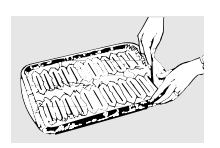
How to Set the Oven for Broiling
- Place the food on the broiler grid in the broiler pan.
- Follow suggested shelf positions in the Broiling guide.
- Turn the Oven Temperature knob to BROIL. (On some models, you must push the knob in before turning.)

Broiling guide
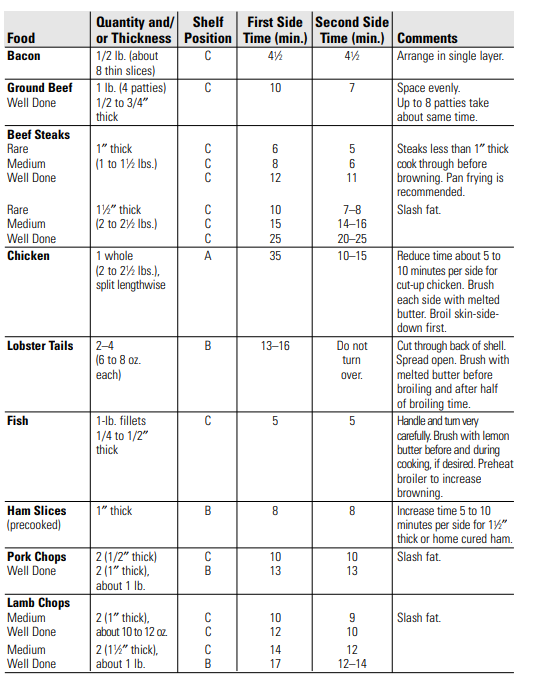
Using CircuWave™ (on some models)
Benefits of CircuWave
- Saves time (up to 30%) when roasting meats and cooking casseroles, whole meals and main dishes. Time savings will depend on size, type and amount of food.
- Seals in moisture while the outside of meats and poultry gets crisp and brown.
- By reducing cooking time, you will save energy and reduce heat in the kitchen.
- The greatest time savings and best results are seen with foods that require more than 45 minutes cooking time.
CircuWave Fan

In the CircuWave oven, a fan circulates the hot oven air over and around the food.
This circulating hot air is evenly distributed throughout the oven cavity.
The CircuWave fan will remain on when the oven door is opened.
To reduce smoking, avoid turning the fan on while broiling.
For best baking results with two racks, place the racks in B and D positions
To Set the Oven for CircuWave
- Turn the knob to the desired oven temperature.
- Push the CircuWave switch to turn on the CircuWave fan.
- After cooking is finished, turn the oven off and push the CircuWave button to turn the fan off.

Tips when using CircuWave
- Be sure to check the internal temperature of food to make sure that it is cooked thoroughly. Meat should be cooked to at least 160° F. and poultry to at least 180° F. Even though food is nicely browned on the outside, it may not have reached a safe internal temperature. Cooking to these temperatures usually protects against foodborne illness.
- Do not turn the fan on during the self-clean cycle.
- To reduce smoking, avoid turning the fan on while broiling
Using the clock and timer. (on some models)
The clock must be set for the automatic oven timing functions to work properly. The time of day cannot be changed during a timed baking or self-cleaning cycle.
To Set the Clock:
- Press the CLOCK pad.
- Press the HOUR and MIN. or SET TIME +/- pads.
- Press the CLOCK pad to start

To Set the Timer:
- Press the TIMER ON/OFF pad.
- Press the HOUR and MIN. or SET TIME +/- pads until the amount of time you want shows in the display. The timer will start automatically within a few seconds of releasing the pad.
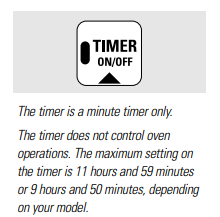
To Reset the Timer:
If the display is still showing the time remaining, you may change it by pressing the HOUR and MIN. or SET TIME +/- pads until the time you want appears in the display.
If the remaining time is not in the display, recall the remaining time by pressing the TIMER ON/OFF pad and then pressing the HOUR and MIN. or SET TIME +/- pads until the new time you want shows in the display.
To Cancel the Timer:
Press the TIMER ON/OFF pad once. To cancel the timer press the TIMER ON/OFF pad again and hold for 4 seconds.
End of Cycle Tones (on some models)
Clear the tones by pressing the pad of the function you are using

Using the timed baking and roasting features. (on some models)
Do not latch the oven door during timed cooking. The latch is used for self-cleaning only.
NOTE: Foods that spoil easily, such as milk, eggs, fish, stuffings, poultry and pork, should not be allowed to sit for more than 1 hour before or after cooking. Room temperature promotes the growth of harmful bacteria. Be sure that the oven light is off because heat from the bulb will speed harmful bacteria growth.
How to Set an Immediate Start and Automatic Stop
Make sure the oven clock shows the correct time of day

- Press COOK TIME ON/OFF.
- Using the HOUR and MIN. pads, enter the length of cooking time.
- Turn the Oven Temperature knob to the desired temperature. (On some models, you must push the knob in before turning.)
The display will show the cooking time remaining.
When the oven reaches the set temperature, a tone sounds. When the oven automatically turns off the AUTOMATIC OVEN light will flash and the oven will signal. Turn the oven control to OFF to stop the flashes and signal.
How to Set a Delay Start and Automatic Stop
Make sure the oven clock shows the correct time of day.

- Press START TIME ON/OFF.
- Using the HOUR and MIN. pads, enter the time you want cooking to start.
- Press COOK TIME ON/OFF.
- Using the HOUR and MIN. pads, enter length of cooking time.
- Turn the Oven Temperature knob to the desired temperature. (On some models, you must push the knob in before turning.)
When the oven automatically turns off the AUTOMATIC OVEN light will flash and the oven will signal. Turn the Oven Temperature knob to OFF to stop the flashes and signal.
Adjust the oven thermostat—Easy to do yourself!
You may find that your new oven cooks differently than the one it replaced. Use your new oven for a few weeks to become more familiar with it. If you still think your new oven is too hot or too cold, you can adjust the thermostat yourself.
Do not use thermometers, such as those found in grocery stores, to check the temperature setting of your oven. These thermometers may vary 20–40 degrees.
NOTE: This adjustment will not affect the broiling or the self-cleaning temperatures (on some models). The adjustment will be retained in memory after a power failure.
For Self-Cleaning Models with Only an Oven Temperature Knob

- Put the knob in the OFF position.
- Pull the knob off by pulling straight out.
- Press and hold the HOTTER or COOLER button for 5 seconds to make the oven 20°F. hotter or 20°F. cooler.
- Replace the knob.
When you are adjusting the thermostat, the following lights will flash indicating where the thermostat will be set when you release the adjustment button:
- OVEN ON: Indicates the thermostat will be set at the factory setting.
- PREHEATED: Indicates the thermostat will be set 20°F. hotter.
- CLEAN: Indicates the thermostat will be set 20°F. cooler
For Self-Cleaning Models with Pads and an Oven Temperature Knob

- Put the Oven Temperature knob in the OFF position.
- Press and hold the HOUR +/– pads for 5 seconds until the display changes.
- Before display changes back, press the HOUR +/– pads to increase or decrease the temperature in 5 degree increments. The oven temperature can be increased up to 35°F. hotter or can be decreased down to 35°F. cooler. If the oven adjustment is set cooler than the factory setting a minus sign (–) and the offset temperature will appear in the display.
- Wait several seconds for the control to automatically set and return to its previous setting
To Adjust the Thermostat on Standard Clean Models

- Pull the Oven Temp knob off the shaft, look at the back of the knob and note the current setting before making any adjustments.
- Loosen both screws on the back of the knob.
- To increase the oven temperature, move the pointer 1 notch toward the words “MAKE HOTTER.” To decrease the oven temperature, turn the pointer 1 notch toward the words “MAKE COOLER.” Each notch changes the temperature by 10 degrees Fahrenheit.
- Tighten the screws.
- Replace the knob, matching the flat area of the knob to the shaft.
Using the self-cleaning oven (on some models).
Before a Clean Cycle
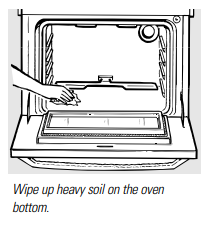
The range must be completely cool in order to set the self-clean cycle.
We recommend venting with an open window or using a ventilation fan or hood during the first self-clean cycle.
Remove all cookware and any aluminum foil from the oven.
The oven shelves can be self-cleaned, but they will darken, lose their luster and become hard to slide.
Do not use abrasives or oven cleaners. Clean the top, sides and outside of the oven door with soap and water.
The enamel grid and broiler pan may be cleaned in the self-cleaning oven. However, to help prevent heavy smoke caused by self-cleaning the greasy soil in the pan, you must first clean off the excess grease.
Make sure the oven light bulb cover is in place and the oven light is off.
IMPORTANT: The health of some birds is extremely sensitive to the fumes given off during the self-cleaning cycle of any range. Move birds to another well ventilated room.
How to Set the Oven for Cleaning

- Latch the door.
- Turn the Oven Temperature knob to CLEAN. (On some models, you must push the knob in before turning.)
Clean cycle time is normally 4 hours and 20 minutes. On models with COOK TIME and START TIME pads, you can change the clean time to between 3 hours and 5 hours, 59 minutes by using the HOUR and MIN. pads. The display will show the clean time counting down.
When the CLEAN light flashes, and the oven has completely cooled, slide the latch handle to the left, and turn the Oven Temperature knob to OFF. Never force the latch handle. You may damage the door lock.
To stop a clean cycle, turn the Oven Temperature knob to OFF. Wait until the oven has cooled and unlatch the door
How to Delay the Start of Cleaning (on some models)
- Latch the door.
- Turn the Oven Temperature knob to CLEAN. (On some models, you must push the knob in before turning.)
- Press the START TIME ON/OFF pad.
- Press the HOUR and MIN. pads to set the time cleaning will start
When the CLEAN light flashes, and the oven has completely cooled, slide the latch handle to the left as far as it will go and turn the Oven Temperature knob to OFF.

After a Clean Cycle
You may notice some white ash in the oven. Wipe it up with a damp cloth after the oven cools.
If white spots remain, remove them with a soap-filled steel wool pad and rinse thoroughly with a vinegar and water mixture.
These deposits are usually a salt residue that cannot be removed by the clean cycle.
If the oven is not clean after one clean cycle, repeat the cycle.
- You cannot set the oven for cooking until the oven is cool enough for the door to be unlatched.
- While the oven is self-cleaning, you can press the CLOCK pad to display the time of day. To return to the clean countdown, press the COOK TIME ON/OFF pad.
- If the shelves become hard to slide, apply a small amount of vegetable oil or cooking oil to a paper towel and wipe the edges of the oven shelves with the paper towel.
Care and cleaning of the range.
Oven Interior (non-self clean models)
- With proper care, the porcelain enamel finish on the inside of the oven—top, bottom, sides, back and inside of the door—will stay new-looking for years.
- Let the range cool before cleaning. We recommend that you wear rubber gloves when cleaning the range.
- Soap and water will normally do the job. Heavy spattering or spillovers may require cleaning with a mild abrasive cleaner. Soapy, wet metal pads may also be used.
- Do not allow food spills with a high sugar or acid content (such as milk, tomatoes, sauerkraut, fruit juices or pie filling) to remain on the surface. They may cause a dull spot even after cleaning.
- Household ammonia may make the cleaning job easier. Place cup in a shallow glass or pottery container in a cold oven overnight. The ammonia fumes will help loosen the burned-on grease and food.
- If necessary, you may use an oven cleaner. Follow the package directions.
Do not spray oven cleaner on the electrical controls and switches because it could cause a short circuit and result in sparking or fire.
Do not allow a film from the cleaner to build up on the temperature sensor—it could cause the oven to heat improperly. (The sensor is located at the top of the oven.) Carefully wipe the sensor clean after each oven cleaning, being careful not to move the sensor as a change in its position could affect how the oven bakes.
Do not spray any oven cleaner on the oven door, handles or any exterior surface of the oven, cabinets or painted surfaces. The cleaner can damage these surfaces.
Lift-Off Oven Door

The oven door is removable for cleaning.
Do not lift the door by the handle. Make sure the oven is completely cool.
- To remove the door, open it to the special stop position. Grasp firmly on each side and lift the door straight up and off the hinges. Do not place hands between the hinge and the oven door frame.
- To replace the door, make sure the hinges are in the special stop position. Position the slots in the bottom of the door squarely over the hinges and slowly lower it over both hinges.
- To clean the inside of the door:
- Soap and water will normally do the job. Heavy spattering or spillovers may require cleaning with a mild abrasive cleaner. Soapy, wet metal pads may also be used.
- Do not allow food spills with a high sugar or acid content (such as milk, tomatoes, sauerkraut, fruit juices or pie filling) to remain on the surface. They may cause a dull spot even after cleaning.
- To clean the outside of the door:
- Use soap and water to thoroughly clean the top, sides and front of the oven door. Rinse well. You may also use a glass cleaner to clean the glass on the outside of the door. Do not let water drip into the vent openings.
- Spillage of marinades, fruit juices, tomato sauces and basting materials containing acids may cause discoloration and should be wiped up immediately. When surface is cool, clean and rinse.
- Do not use oven cleaners, cleaning powders or harsh abrasives on the outside of the door.
Oven Heating Elements

Do not clean the bake element or the broil element. Any soil will burn off when the elements are heated.
To clean the oven floor, gently lift the bake element. Clean with warm soapy water.
Oven Shelves

Clean the shelves with an abrasive cleanser or steel wool.
On self-cleaning models the oven shelves may be cleaned in the self-cleaning oven. However, the shelves will darken in color, lose their luster and become hard to slide if cleaned during the self-cleaning cycle.
To make the shelves slide more easily apply a small amount of vegetable oil or cooking oil to a paper towel and wipe the edges of the oven shelves with the paper towel.
Oven Light Replacement (on some models)

CAUTION: Before replacing your oven light bulb, disconnect the electrical power to the range at the main fuse or circuit breaker panel.
Be sure to let the light cover and bulb cool completely.
To remove the cover:
- Hold a hand under the cover so it doesn’t fall when released. With fingers of the same hand, firmly push back the wire cover holder. Lift off the cover. Do not remove any screws to remove the cover.
- Replace bulb with a 40-watt household appliance bulb.
To replace the cover:
- Place it into groove of the light receptacle. Pull wire forward to the center of the cover until it snaps into place.
- Connect electrical power to the range.
Broiler Pan & Grid

After broiling, remove the broiler pan from the oven. Remove the grid from the pan. Carefully pour out the grease from the pan into a proper container.
Wash and rinse the broiler pan and grid in hot water with a soap-filled or plastic scouring pad.
If food has burned on, sprinkle the grid with detergent while hot and cover with wet paper towels or a dishcloth. Soaking the pan will remove burned-on foods.
The broiler pan may be cleaned with a commercial oven cleaner. If the grid is grey enamel, it can also be cleaned with an oven cleaner. If the grid is chrome, do not use an oven cleaner to clean it.
Both the broiler pan and grid can also be cleaned in the dishwasher. Do not store a soiled broiler pan and grid anywhere in the range.
How to Remove the Storage Drawer to Clean Under the Range

To remove the storage drawer:
- Pull the drawer out all the way.
- Tilt up the front and remove it.
To replace the storage drawer:
- Insert glides at the back of the drawer beyond the stop on range glides.
- Lift the drawer if necessary to insert easily.
- Let the front of the drawer down, then push in to close.
Control Panel and Knobs
Clean up spatters with a damp cloth. Remove heavier soil with warm, soapy water.
Do not use abrasives of any kind on the control panel.
The control knobs may be removed for easier cleaning. To remove a knob, pull it straight off the stem. Wash the knobs in soap and water but do not soak.
Oven Vent
On glass cooktop models, the oven is vented through an opening at the rear of the cooktop.
On coil cooktop models, the oven is vented through an opening under the right rear surface unit.
Never cover the opening with aluminum foil or any other material.
Painted Surfaces
Painted surfaces include the sides and the drawer front.
Clean these with soap and water or a vinegar and water solution.
Do not use commercial oven cleaners, cleaning powders, steel wool or harsh abrasives on any painted surface.
Glass Window (on some models)
To clean the outside glass finish, use a glass cleaner. Rinse and polish with a dry cloth.
Cleaning the glass cooktop.
Clean the glass surface with cleaning cream before you use the cooktop for the first time. Also, clean the glass surface after each use. This helps protect the top and makes clean-up easier.
To clean the cooktop seal, let a wet cloth rest on it for a few minutes, then wipe clean. Use a mild detergent if needed.
Do not use a knife or any sharp object on the seal because it will cut or damage it.
Daily Cleaning
Use only a recommended cleaning cream, such as Cerama Brite or the Cooktop Cleaning Creme, on the glass cooktop.
To maintain and protect the surface of your new glass cooktop follow these steps.
Before you use the cooktop for the first time, clean it with cleaning cream. This helps protect the top and makes clean-up easier.
- Clean the surface with the cleaning cream after each use.
- Rub a few drops (less is better) of the cleaning cream onto soiled area using a damp paper towel. Buff with a dry paper towel until all soil and cream are removed.
For heavy, burned-on soil:
- Apply a few drops of the cleaning cream to the (cool) soiled area.
- Using a damp paper towel, rub the cream into the burned-on area. As with any burned-on spill, this may require some effort.
- Carefully scrape soil with razor scraper. Hold scraper at a 45° angle against the glass cooktop.
- If any soil remains, repeat the steps listed above. For additional protection, after all soil has been removed, polish the entire surface with the cleaning cream.
- Buff with a dry paper towel.
Special Care

Sugary spillovers (such as jellies, fudge, candy syrups) or melted plastics can cause pitting of the surface of your cooktop (not covered by the warranty) unless the spill is removed while still hot. Special care should be taken when removing hot substances.
- Turn off all surface units affected by the spillover. Remove hot pans.
- Wearing an oven mitt, hold the razor scraper at a 45° angle to the cooktop. Scrape the hot spill to a cool area outside the surface unit.
- With the spill in a cool area, use a dry paper towel to remove any excess. Any spillover remaining should be left until the surface of the cooktop has cooled. Do not continue to use the soiled surface unit until all of the spillover has been removed. Follow the steps under Heavy soil to continue the cleaning process.
NOTE: If pots with a thin overlay of aluminum, copper or enamel are allowed to boil dry, the overlay may bond with the glass cooktop and leave a black discoloration. This should be removed immediately before heating again or the discoloration may be permanent
Porcelain Enamel Cooktop
The porcelain enamel finish is sturdy but breakable if misused. This finish is acid-resistant. However, any acidic foods spilled (such as fruit juices, tomato or vinegar) should not be permitted to remain on the finish.
If acids spill on the cooktop while it is hot, use a dry paper towel or cloth to wipe it up right away. When the surface has cooled, wash with soap and water. Rinse well.
For other spills such as fat spatterings, wash with soap and water or cleansing powders after the surface has cooled. Rinse well. Polish with a dry cloth.
Lift-Up Cooktop (on some models)
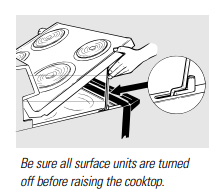
Some models have a cooktop that can be lifted up for easier cleaning.
The entire cooktop may be lifted up and supported in the up position. The surface units do not need to be removed; however, you may remove one to make raising the cooktop easier. There are two side supports that lock into position when the cooktop is lifted up.
After cleaning under the cooktop with hot, mild soapy water and a clean cloth, lower the cooktop. Be careful not to pinch your fingers.
To lower the cooktop, push the rods back and gently lower the cooktop until it rests in place.
Surface Units (on some models)

To clean the surface units, turn the control to the highest setting for a minute. The coils will burn off any soil.
To remove a surface unit:
- To remove the drip pans for cleaning, the surface units must be removed first.
- Lift the surface unit about 1 inch above the drip pan and pull it out.
- Do not lift the surface unit more than 1 inch. If you do, it may not lie flat on the drip pan when you plug it back in.
- Repeated lifting of the surface unit more than 1 inch above the drip pan can permanently damage the receptacle.
To replace a surface unit:
- Replace the drip pan into the recess in the cooktop. Make sure the opening in the pan lines up with the receptacle.
- Insert the terminals of the surface unit through the opening in the drip pan and into the receptacle.
- Guide the surface unit into place so it rests evenly.
Drip Pans (on some models)
Remove the surface units. Then lift out the drip pans.
For best results, clean the drip pans by hand. Place them in a covered container (or a plastic bag) with 1/4 cup ammonia to loosen the soil. Then scrub with a soap-filled scouring pad if necessary. Rinse with clean water and polish with a clean soft cloth.
The drip pans may also be cleaned in the dishwasher.
Clean the area under the drip pans often. Built-up soil, especially grease, may catch fire.
Do not cover the drip pans with foil. Using foil so close to the receptacle could cause shock, fire or damage to the range.
Installation Instructions
Installation of the range.
Before You Begin
IMPORTANT: Save these instructions for the local electrical inspector’s use.
IMPORTANT: OBSERVE ALL GOVERNING CODES AND ORDINANCES.
NOTE TO INSTALLER: Leave these instructions with the appliance after installation is completed.
NOTE TO CONSUMER: Keep this Owner’s Manual and Installation Instructions for future use.
NOTE: This appliance must be properly grounded.
Tools You Will Need
- Large blade screwdriver
- 1/4″ hex head nutdriver
- Channel lock pliers
Electrical Requirements
CAUTION, FOR PERSONAL SAFETY: DO NOT USE AN EXTENSION CORD WITH THIS APPLIANCE. REMOVE HOUSE FUSE OR OPEN CIRCUIT BREAKER BEFORE BEGINNING INSTALLATION
This appliance must be supplied with the proper voltage and frequency, and connected to an individual, properly grounded branch circuit, protected by a circuit breaker or time delay fuse, as noted on the rating plate.
Wiring must conform to National Electric Codes.
If the electric service provided does not meet the above specifications, have a licensed electrician install an approved outlet.
Because range terminals are not accessible after range is in position, flexible service conduit or cord must be used.
1. Prepare the Opening
Allow 11⁄2″ spacing from the range to adjacent vertical walls above cooktop surface.
Allow 30″ minimum clearance between surface units and bottom of unprotected wood or metal top cabinet, and 15″ minimum between countertop and adjacent cabinet bottom.
EXCEPTION: Installation of a listed microwave oven or cooking appliance over the cooktop shall conform to the installation instructions packed with that appliance.
If cabinet storage is installed, reduce risk by installing a range hood that projects horizontally a min. of 5″ beyond the bottom of the cabinets. Make sure the wall covering, countertops and cabinets around the range can withstand heat generated by the range, oven or cooktop up to 200°F

Flooring Under the Range
- Your range, like many other household items, is heavy and can settle into soft floor coverings such as cushioned vinyl or carpeting.
- When moving the range on this type of flooring, it should be installed on a 1/4″ thick sheet of plywood (or similar material) as follows: When the floor covering ends at the front of the range, the area that the range will rest on should be built up with plywood to the same level or higher than the floor covering. This will allow the range to be moved for cleaning or servicing
2. Prepare for Electrical Connection
Effective January 1, 1996 the National Electric Code requires that new construction (not existing) utilize a 4-conductor connection to an electric range. When installing an electric range in new construction follow Steps 3 and 5 for 4-wire connection
Use only a 3-conductor or a 4-conductor UL-listed range cord. These cords may be provided with ring terminals on wire and a strain relief device.
A range cord rated at 40 amps with 125/250 minimum volt range is required. A 50 amp range cord is not recommended but if used, it should be marked for use with nominal 13⁄8″ diameter connection openings. Care should be taken to center the cable and strain relief within the knockout hole to keep the edge from damaging the cable.
NOTE: A 4-conductor cord is to be used when the appliance is installed in a mobile home or when local codes do not permit grounding through the neutral. If conduit is being used, go to Step 6 or 7.
3. Power Cord Strain Relief Installation
1. Remove the lower rear range wiring cover to expose the connector block and bracket.
2. Remove the knockout ring (13⁄8″) located on bracket directly below the connector. To remove the knockout, use a pair of pliers to bend the knockout ring away from the bracket and twist until ring is removed.

3. Assemble the strain relief in the hole. Insert the power cord through the strain relief and tighten. Allow enough slack to easily attach the cord terminals to the connector block. If tabs are present at the end of the winged strain relief, they can be removed for better fit. NOTE: Do not install the power cord without a strain relief. The strain relief bracket should be installed before reinstalling the rear range wiring cover.

4. 3-Wire Power Cord Installation
WARNING: The neutral or ground wire of the power cord must be connected to the neutral terminal located in the center of the connector block. The power leads must be connected to the outside (brass colored) terminals.
Remove the 3 wire terminal screws from the connector block. Insert screws through each power cord terminal ring and into the connector block until the screws engage the nuts. Be certain that the center wire is connected to the center screw of the connector block. Tighten screws securely.
Do NOT remove ground strap connection.

5. 4-Wire Power Cord Installation
WARNING: The neutral wire of the supply circuit is connected to the neutral terminal located in the center of the connector block. The power leads must be connected to the outside (brass colored) terminals.The 4th grounding lead must be connected to the frame of the range with the grounding plate and grounding screw.
- Remove the 3 screws from the connector block.
- Remove the grounding screw and strap from the connector block middle location and the screw connection to the frame of the range.
- Insert screws through each power cord terminal ring and into connector block until screw engages nut. Be certain that the center wire is connected to the center screw of the connector block. Tighten screws securely.
- Attach ground wire to the frame of the range.
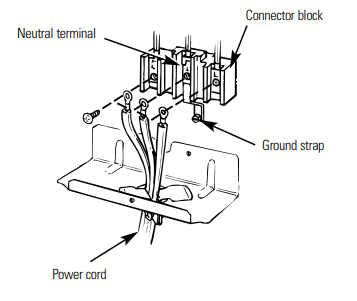
6. 3-Wire Conduit Installation
Remove the 3 screws from the connector block. Insert bare wires between the connector block terminals and movable nuts. Tighten screws securely. Do not remove ground strap connection.
WARNING: Connector block is approved for copper wire connection only. If aluminum wire is used, see note below.
NOTE: ALUMINUM WIRING
- Do not connect aluminum wire to the connector block. Use copper building wire rated for the correct amperage and voltage to make 3 (three) 3″ copper jumper wires. Connect wire as per Step 6 or 7 depending on number of wires.
- Splice copper wires to aluminum wiring using special connector terminals designed and UL-approved for joining copper to aluminum and follow the connector manufacturer’s recommended procedure closely.
Wire used, location and enclosure of splices, etc., must conform to good wiring practices and local codes.

7. 4-Wire Conduit Installation
Remove the 3 screws from the connector block. Remove the grounding strap from the connector block middle location and the screw connecting it to the frame of the range. Insert bare wires between the connector block terminals and movable nuts. Tighten screws securely. Attach ground wire to the frame of the range.
WARNING: Connector block is approved for copper wire connection only. If aluminum wire is used, see note below.
NOTE: ALUMINUM WIRING
- Do not connect aluminum wire to connector block. Use copper building wire rated for the correct amperage and voltage to make 3 (three) 3″ copper jumper wires. Connect wire as per Step 6 or 7 depending on number of wires.
- Splice copper wires to aluminum wiring using special connector terminals designed and UL-approved for joining copper to aluminum and follow the connector manufacturer’s recommended procedure closely.
Wire used, location and enclosure of splices, etc., must conform to good wiring practices and local codes.
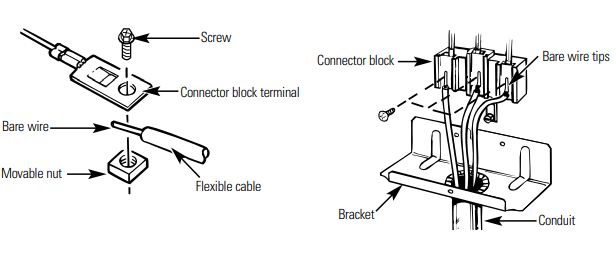
8. Anti-Tip Bracket Installation
An Anti-Tip bracket is supplied with instructions for installation in a variety of locations. The instructions include a template, a parts list and a list of tools necessary to complete the installation. Read the Important Safety Information and the instructions that fit your situation before beginning installation
WARNING
- Range must be secured by Anti-Tip bracket supplied.
- See instructions to install (supplied with bracket).
- Unless properly installed, the range could be tipped by stepping or sitting on the door. Injury might result from spilled hot liquids or from the range itself.

9. Leveling the Range
The range must be level. Leveling feet are located at each corner of the base of the range. Remove the storage drawer. Using channel locks, rotate the leveling feet in and out as required to level the range. (For instructions on how to remove and replace the storage drawer, see the Care and cleaning of the range section.)
On some models, there are plastic covers which may be removed for easy adjustment (just squeeze and pull).
One of the rear leveling feet will engage the Anti-Tip bracket (allow for some side to side adjustment). Allow a minimum clearance of 1/8″ between the range and the leveling foot that is to be installed into the Anti-Tip bracket.
Check the range for proper installation into the Anti-Tip bracket by removing the storage drawer and inspecting the rear leveling leg. Make sure it fits securely into the slot.
10. Final Check
Be sure all range controls are in the OFF position before leaving the range.
Troubleshooting Tips
Glass Cooktops
Surface units will not maintain a rolling boil or cooking is not fast enough
- Improper cookware being used.
- Use pans which are absolutely flat and match the diameter of the surface unit selected.
Surface units do not work properly
- A fuse in your home may be blown or the circuit breaker tripped.
- Replace fuse or reset circuit breaker tripped.
- Cooktop controls improperly set
- Check to see the correct control is set for the surface unit you are using.
Tiny scratches (may appear as cracks) or abrasions on radiant cooktop
- Incorrect cleaning methods being used.
- Use recommended cleaning procedures.
- Cookware with rough bottoms being used or coarse particles (salt or sand) were between the cookware and the surface of the cooktop
- Be sure cookware bottoms and cookware are clean before use. Use cookware with smooth bottoms. Tiny scratches are not removable but will become less visible in timeasa result of cleaning.
- Cookware has been slid across the cooktop surface.
Areas of discoloration on the cooktop
- Improper cookware being used.
- Marks from aluminum and copper pans as well as mineral deposits from water or food can be removed with the cleaning cream.
Hot sugar mixtures or plastic melted to the surface
- Hot cooktop came into contact with these substances.
- See the Cleaning the glass cooktop section.
Frequent cycling off and on of surface units
- Improper cookware being used.
- Use only flat cookware to minimize cycling.
Coil Cooktops
Surface units not functioning properly
-
The surface units are not plugged in solidly.
-
With the controls off. check to make sure the surface unitis plugged completely into the receptacle.
-
-
The surface unit controls improperly set.
-
Check to see the correct control is set for the surface unit you are using.
-
-
The drip pans are not set securely in the cooktop.
-
With the controls off. check to make sure the drip pan is in the recess in the cooktop and that the opening in the pan lines up with the receptacle.
-
Oven-All Models
Oven light does not work
- Light bulb is loose or defective.
-
Tighten or replace the bulb.
-
- Switch operating light is broken.
- Call for service.
Oven will not work
- Plug on range is not completely inserted in the electrical outlet.
- Make sure electrical plug is plugged into alive. properly grounded outlet.
- A fuse in your home may be blown or the circuit breaker tripped.
- Replace fuse or reset circuit breaker.
- Oven controls improperly set
- See the Using the oven section.
- On self-cleaning models, door left in the locked position.
- If necessary. allow the oven to cool then unlock the door.
Food does not bake or roast properly
- Oven controls improperly set.
- See the Using the oven section.
- Shelf position is incorrect or the shelf is not level
- See the Using the oven section.
- Incorrect cookware or cookware of improper size being used.
- See the Using the oven section.
- Oven thermostat needs adjustment
- See the Adjust the oven thermostat—Easy to do yourself! section.
- More than one oven rack used.
- Use just one rack for best results with cakes and cookies when baking without CircuWave.
- CircuWave fan used on incorrect food type.
- See the Using CircuWave section.
Food does not broil properly
-
Oven is not set at BROIL.
-
Make sure you turn the knob all the way to the BROIL position.
-
-
Door not open to the broil stop position as recommended.
-
See the Using the oven section.
-
-
Improper shelf position being used.
-
See the Broiling guide.
-
-
Food being cooked in ahot pan.
-
Use the broiling pan and grid that came with your range. Make sure it is cool.
-
-
Cookware not suited for broiling.
-
Use the broiling pan and grid that came with your range.
-
-
Aluminum foil used on the broiling pan and grid has not been fitted properly and slit as recommended.
-
See the Using the oven section.
-
Food does not broil properly
- In some areas the power (voltage) may be low.
-
Preheat the broil element for 10 minutes.
-
Broil for the longest period of time recommended in the Broiling guide.
-
Oven temperature too hot or too cold
- Oven thermostat needs adjustment.
- See the Adjust the oven thermostat—Easy to do yourself! section.
Clock and timer do not work
-
Plug on range is not completely inserted in the electrical outlet.
-
Make sure electrical plug is plugged into a live. properly grounded outlet.
-
-
A fuse in your home may be blown or the circuit breaker tripped.
-
Replace fuse or reset circuit breaker.
-
-
Oven controls improperly set.
-
See the Using the clock and timer section.
-
The display goes blank or indicator lights come on when range is not in use
- Power surge.
- Disconnect power at the fuse box or circuit breaker for at least 10 seconds. Turn power on and power up your range. If the indicator lights are still on, call for service.
Oven door is crooked
- The door is out of position.
- Because the oven door is removable. it sometimes gets out of position during installation. To straighten the door. push down on the high corner.
Oven makes clicking noise
- This is the sound of the heating element turning off and on during cooking functions.
- This is normal.
Excessive smoke during broiling
- CircuWave fan is on during broiling.
- Do not use the CircuWave fan during broiling.
“F—and a number” flash in the display
- You have a function error code.
- Disconnect all power to the range for 5 minutes and then reconnect power. If the function error code repeats. call for service.
- On self-cleaning models. ifa function error code appears during the self cleaning cycle. check the oven door latch. The latch may have been moved. even if only slightly. from the locked position. Make sure the latch is moved to the right as far as it will go. Turn the Oven Temperature knob to OFF. Allow the oven to cool for one hour. Put the oven back into operation.
Power outage
- Power outage or surge.
- Some models will automatically resume their setting once the power is restored. On models with a clock, you must reset the clock. If the oven was in use, you must reset it by turning the Oven Temperature knob back to OFF, setting the clock and resetting any cooking function.
Self-Cleaning Models
Oven will not self-clean
- The oven temperature is too high to seta self-clean operation.
- Allow the range to cool to room temperature and reset the controls.
- Oven controls improperly set.
- Make sure you turn the control knob all the way to the CLEAN position.
- Oven door is not in the locked position.
- Make sure you move the door latch handle all the way to the right.
Oven starts a self-clean cycle when you wanted to bake. roast or broil
- Oven door locked
- Turn the Oven Temperature knob to OFF. Allow the oven to cool. Never force the door latch handle.
“Crackling” or “popping” sound
- This is the sound of the metal heating and cooling during both the cooking and cleaning functions.
- This is normal.
Excessive smoking
- Excessive soil.
- Turn the Oven Temperature knob to OFF. Open the windows to rid the room of smoke. Wait until the CLEAN light goes off. Wipe up the excess soil and reset the clean cycle.
- CircuWave fan is on.
- Make sure the fan is off during self-cleaning.
Oven door will not unlock
- Oven too hot.
- Allow the oven to cool below locking temperature
CLEAN light is on when you want to cook
- The oven door was accidentally locked.
- Turn the Oven Temperature knob to OFF. Allow the oven to cool. Never force the door latch handle.
Oven not clean after a clean cycle
- Oven controls not properly set.
- See Using the self-cleaning oven section.
- Oven was heavily soiled.
- Clean up heavy spillovers before starting the clean cycle. Heavily soiled ovens may need to self-clean again or for a longer period of time.
CLEAN light flashes
- Oven controls not properly set.
- Move the door latch handle to the right before setting the Oven Temperature knob to CLEAN.
Consumer Product Ownership Registration
Follow these three steps to protect your new appliance investment:
- Complete and mail your Consumer Product Ownership Registration today. Have the peace of mind of knowing we can contact you in the unlikely event of a safety modification.
- After mailing the registration below, store this document in a safe place. It contains information you will need should you require service. Our service number is 800 GE CARES (800-432-2737).
- Read your Owner’s Manual carefully. It will help you operate your new appliance properly. If you have questions, or need more information, call the GE Answer Center® 800.626.2000.
Important: If you did not get a registration card with your product, detach and return the form below to ensure that your product is registered, or register online at www.geappliances.com.
Electric Range Warranty
One Year: From the date of the original purchase
- Any part of the range which fails due to a defect in materials or workmanship. During this full one-year warranty, we will also provide, free of charge, all labor and in-home service to replace the defective part.
FOR MODELS JBP61, JBP63, AND JBS61 ONLY:
Five Years: From the date of the original purchase
- A replacement glass cooktop if it should: crack due to thermal shock; discolor; crack at the rubber seal between the glass cooktop and the porcelain edge. It will also be replaced if the pattern wears off or if any of the radiant surface units burn out. During this additional four-year limited warranty, you will be responsible for any labor or in-home service costs.
What We Will Not Cover:
- Service trips to your home to teach you how to use the product.
- Improper installation.
- Failure of the product if it is abused, misused, or used for other than the intended purpose or used commercially.
- Damage to the glass cooktop caused by use of cleaners other than the recommended cleaning creams.
- Replacement of house fuses or resetting of circuit breakers.
- Damage to the glass cooktop caused by hardened spills of sugary materials or melted plastic that are not cleaned according to the directions in the Owner’s Manual.
- Damage to the product caused by accident, fire, floods or acts of God.
- Incidental or consequential damage to personal property caused by possible defects with this appliance.
This warranty is extended to the original purchaser and any succeeding owner for products purchased for home use within the USA. In Alaska, the warranty excludes the cost of shipping or service calls to your home.
Some states do not allow the exclusion or limitation of incidental or consequential damages. This warranty gives you specific legal rights, and you may also have other rights which vary from state to state. To know what your legal rights are, consult your local or state consumer affairs office or your state’s Attorney General.
See other models: GSS25LSLSS PP989SNSS UVD6361DPBB 34455 RCA
